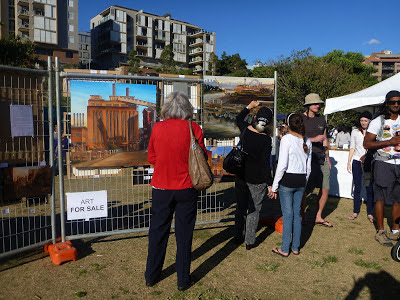"Dalgety Terrace Millers Point"
2014 oil on canvas 46 x 61cm Collection : Mitchell Library, State Library of NSW Enquiries about similar paintings
The Harbour Control Tower looms ominously over the row of ramshackle terraces on the sandstone block wall of Dalgety Road.
Some of the houses sport protest banners :"Millers Point not 4 sale" "Our community is worth more than money"
Fortunately some of the banners were still there long enough for me to paint them, however, a few weeks afterwards the Housing NSW Millers Point Relocation Team had torn them down.
Housing NSW's Relocation Officers and their security and "cleansing" teams have been removing banners and photos of residents throughout Millers Point. The banners on the Garrison Church Rectory and on St Brigid's Church were removed in January 2015.
"Dalgety Terrace Millers Point"
2014 oil on canvas 46 x 61cm Collection : Mitchell Library, State Library of NSW Enquiries about similar paintings
Luckily I finished painting this canvas just before the roadwork started.
I was set up between 2 of the hideous new apartments built several years ago to replace a set of old Maritime Services Board warehouses.  |
"Dalgety Terrace Millers Point"
2014 oil on canvas 46 x 61cm Collection : Mitchell Library, State Library of NSW Enquiries about similar paintings
To add insult to injury,there is now a serious attempt to remove even the name "Millers Point" from the suburb- see Don't erase Millers Point Facebook Page
This canvas, which I exhibited in my solo exhibition "Under the Hammer" Frances Keevil Gallery 2014, was recently acquired for the collection of the Mitchell Library, State Library of NSW.
My canvases are banners that can never be torn down.
|
About Me

- Jane Bennett Artist
- Sydney, NSW, Australia
- I'm an Industrial Heritage Artist who paints "en plein air".If it's damaged, derelict, doomed and about to disappear, I'll be there to paint it.
Showing posts with label Frances Keevil Gallery. Show all posts
Showing posts with label Frances Keevil Gallery. Show all posts
Tuesday, 17 February 2015
Banners, Millers Point
Sunday, 30 November 2014
Patina- Beautiful decay
 |
| GIHC16 'Detail Hammerhead Crane' 2014 oil on canvas 28 x 36cm SOLD PRIVATE COLLECTION : SYDNEY |
In my major solo exhibition "Under the Hammer" at the Frances Keevil Gallery there are several paintings of the Hammerhead Crane seen from various vantage points in the middle distance.
However, I also painted several canvases of close-up details that at first sight look like abstract works. I can assure you, they are completely realistic. They just focus on a tiny portion of the subject, unlike most of my work. These paintings have been wildly popular, but I wonder whether it is just because onlookers have become less capable of coping with the complexity of an entire scene, and are only able to appreciate a fragment.
 |
| GIHC18 'Girder, Hammerhead Crane 2014 oil on canvas 61 x 91cm FINALIST : 2015 HORNSBY ART PRIZE Enquiries |
Now I can't overstate how much I hate the flat picture plane!
And "modern" art has been all about "the surface", flatness and shallowness, in more ways than one.
In my paintings, I want depth, perspective and layers; physically, emotionally and intellectually.
So even in my canvases of close-up details, there are hidden depths and a sense of space extending beyond the picture plane, especially in the drawings and paintings I created while looking up, standing directly underneath the centre of the crane. I feel that the painting with the greatest sense of space and depth is "Under the Hammerhead Crane" seen below.
However these canvases of details of the Hammerhead Crane have given me the chance to reveal the transmutations, ambiguities and impermanence of form by the beauty of its decaying exterior.
 |
| GIHC20 'Under the Hammerhead Crane' 2014 oil on canvas 61 x 91cm Enquiries |
Patina is the visible sign of age on the surface of a material. It panders to our growing desire for the proof of authenticity; a backlash against the homogenized and generic corporate spaces that have taken over so much of our world. Materials are imbued with a history that speaks of ‘natural’ processes accrued over time, such as distressed wood, weather-beaten stone or brick, faded wallpaper, well-worn textiles, rusted ironwork, greening copper - the valued hallmarks of "shabby chic" in upmarket interior decor.
If you lose the texture, you lose your history.
The irony is that patina is seen as adding "authenticity", even though it has been caused by the degeneration and instability of the object.
I think of rust on a metal structure as though it is blood dripping from a wound.
Worship of patina can be seen as yet another symptom of the post-modern obsession with surface at the expense of ‘authentic’ depth.
Patina can be a by-product of the natural process of ageing, but it also functions as a memorial to disaster, natural or otherwise- the architectural equivalent of post-traumatic stress, showing the ‘wound’ inflicted by the trauma of the past as it reverberates down into the present.
Patina straddles the space and time between construction and ruin. The allure of patina lies in its instability; because any attempt to stabilise it affects the essential process.
The art critic Walter Benjamin said that the ‘real’ is only revealed in moments of ruination.
As with ruins, patina represents a fragment that suggests the meaning of the whole. Patina holds together contradictions, reveals historical depth, and yet ironically also remembrance and even healing.
Open from Tuesday 18th November – Sunday 7th December
Related posts
Ozymandias
Rust never sleeps : Painting the Hammerhead Crane Part 2
Painting the Hammerhead crane Part 1
Rust never sleeps : Painting the Hammerhead Crane Part 2
Painting the Hammerhead crane Part 1
Sunday, 2 June 2013
Not the Writers Festival- Exhibition of Pyrmont Paintings by Jane Bennett at 2013 Pyrmont Festival
I exhibited these historic paintings of Pyrmont at the 2013 Pyrmont festival in conjunction with the Frances Keevil Gallery
There were several sales and I am now preparing to paint an extremely large and prestigious commission resulting from a contact made on these 2 days.
Paintings of Pyrmont by Jane Bennett in Pirrama Park
We like sheep - Waite and Bull Building
Artist in Residence at the Sydney Heritage Fleet Part 6
Pyrmont paintings past and present- My Exhibition in the Australian National Maritime Museum
 |
Exhibition of paintings of Pyrmont by Jane Bennett at the 2013 Pyrmont Festival
|
The weather couldn't have been better for the 2013 Pyrmont Festival. A couple of the calmest, sunniest autumn days I've ever experienced in Sydney.
This festival is held on the former Water-Police site, where I used to have several studios during the late 1980s - mid 1990s.
 |
Exhibition of paintings of Pyrmont by Jane Bennett at the 2013 Pyrmont Festival
|
This time the festival in Pirrama Park was for the whole weekend, which gave many more people a chance to see my exhibition.
I had brought 55 paintings on canvas and board for the exhibition. The largest was the 61 x 183cm canvas of a panorama of "Union Square" and the smallest was a tiny canvas of a strange little sign on top of the former F.L. Barker/Waite and Bull woolstore on the corner of Pyrmont Street and Pyrmont Bridge Road.
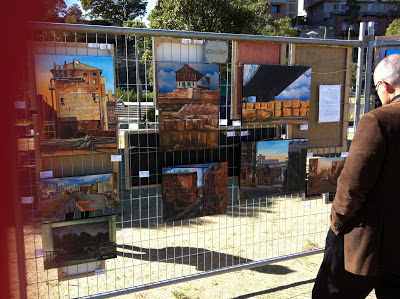 |
Exhibition of paintings of Pyrmont by Jane Bennett at the 2013 Pyrmont Festival contact me |
This year I had written 2 small booklets about my paintings and drawings of Pyrmont. The text was partly based on some of the posts in this blog.
 |
Exhibition of paintings of Pyrmont by Jane Bennett at the 2013 Pyrmont Festival contact me |
I only have one of each left now, and I'd better hang on to them as I'd like to have them in front of me when I finally sit down with the gallery's designer and plan a better publication.
So, it's not yet the Writer's Festival, and I'm not an author.
However the reaction has given me a great deal of confidence. People have been nagging me for years to write about my paintings, but now I know that they are serious.
 |
"Decisions, decisions... which one should I buy?"
Exhibition of paintings of Pyrmont by Jane Bennett at the 2013 Pyrmont Festival
|
As well as my unexpected excursion into literature, it was a very interesting and successful event on a number of different levels.
I reconnected with lots of people who once lived or worked in Pyrmont as well as many of the new residents of Jacksons Landing and the apartments on top of Pyrmont Point.
There were several sales and I am now preparing to paint an extremely large and prestigious commission resulting from a contact made on these 2 days.
Paintings of Pyrmont by Jane Bennett in Pirrama Park
Related posts
We like sheep - Waite and Bull Building
Artist in Residence at the Sydney Heritage Fleet Part 6
Pyrmont paintings past and present- My Exhibition in the Australian National Maritime Museum
I started my series of Pyrmont paintings over 30 years ago and I will still paint in Pyrmont occasionally.
If you enjoy my Pyrmont paintings please visit the Frances Keevil Gallery or contact me
Saturday, 16 March 2013
"Lashed to the Mast" - Plein Air painting as extreme sport
I wanted to try painting a large canvas of the spectacular view of Goat Island from Moore's Wharf for my solo exhibition "From the Hungry Mile to Barangaroo" which is now on display at the Frances Keevil Gallery.
I never do anything by halves, so I got the biggest canvas that would fit inside my station wagon - 122 x 183cm!
 |
| My Artist's Studio in a suitcase |
I was worried about the canvas going hang-gliding over Sydney Harbour, or even snapping in two which happened while I was painting the Sydney Heritage Fleet from Blackwattle Bay.
The solution was to take a studio easel as well as a French box easel, and to use cable ties to secure the canvas to the studio easel, and the easel to a large chunk of timber.
The most important thing is not to forget to bring a good sharp pair of scissors to remove the cable ties!
The studio easel had casters so I could move it around without too much trouble. I used the French box easel to store my paint, medium and brushes.
 |
| I've had to cable tie the large canvas to my studio easel |
The renowned 19th century marine painter J.M.W.Turner used to boast that he was once "lashed to the mast" to witness a storm at sea as inspiration.
 |
I've had to cable tie the large canvas to my studio easel- and then cable tie the easel to a timber block!
|
I've always loved Turner's paintings and now I feel that I am literally following in his footsteps!
 |
| Timber block and easel |
Quite literally.
Like Turner,who also had a predilection for painting enormous canvases, I'm also very short, so I had to stand on this useful block of wood so I could reach up to paint the sky!
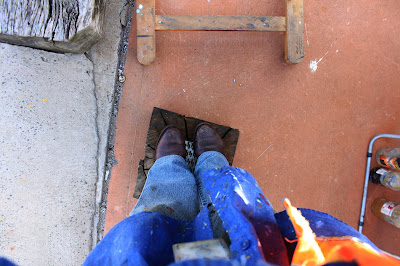 |
| Timber block and easel used by plein air painter Jane Bennett |
 |
| My large plein air painting of Goat Island from Moore's Wharf at about 8am |
The day started bright and sunny, but the clouds gathered quickly.
The calm morning Sydney Harbour seascape I had originally intended to paint was soon transformed into a brooding study of an impending storm.
 |
| My large plein air painting of Goat Island from Moore's Wharf at about 9am |
It feels almost as much like a sport as art.
The amount of physical strength involved in just being able to handle a canvas of this size out in the open air is surprising. I have to work out just so I can keep lugging my easels up and down stairs.
The other thing that is underestimated by the people who view the finished canvas in a pristine white-walled gallery, is the amount of concentration required to sustain the atmosphere over the hours required to finish a work of this size.
 |
| My large plein air painting of Goat Island from Moore's Wharf at about 9.30am |
 |
| My large plein air painting of Goat Island from Moore's Wharf at about 10am |
Apart from the skill needed to paint these fleeting effects, it also takes a great deal of experience and judgement to decide which are worth capturing.
 |
| My large plein air painting of Goat Island from Moore's Wharf at about 11am |
Dark clouds started to cover the sky and the sea changed colour from turquoise to prussian blue, then to slate grey.
The wind whipped up, and I had to decide whether it was too risky to continue.
 |
| My large plein air painting of Goat Island from Moore's Wharf at about noon |
I had almost as much canvas to cope with as some of the smaller yachts out on the harbour, who were starting to have trouble.
And if I wasn't careful, my canvas would have travelled just as fast in the wrong direction!
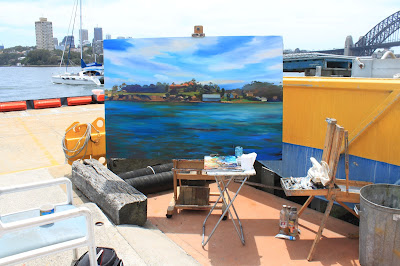 |
| My large plein air painting of Goat Island from Moore's Wharf at about noon |
The sensible choice probably would have been to put the canvas away and start a small study of the stormy conditions.
But I liked the dramatic light effects so much that I took a calculated risk and quickly repainted the canvas to reflect the changed conditions.
 | |
The completed canvas
|
But I'm glad that I took the risk, as the canvas has really captured the colour and mood.
The brilliant yellow buoys surrounding the excavation of the North Barangaroo Headland Park contrast strongly with the ominous sky and dark, choppy sea.
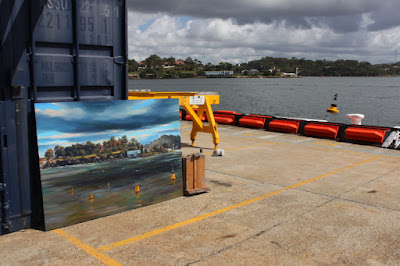 | |
|
 | |
|
This photo best shows the painting in context with the landscape.
However large the canvas actually is, it will always look like a postage stamp compared with the real thing. I can assure you that this canvas is a lot bigger than I am!(I am 5' 1" which is fairly short even for a girl.)By the time I took these photos, I was so worried about the canvas blowing away that I had to cable tie it to the container - I didn't dare risk putting it on the easel!
.JPG) | |
Enquiries about this painting
And finally a few days later, here it is hanging in my solo exhibition "From the Hungry Mile to Barangaroo" at the Frances Keevil Gallery.
|
Subscribe to:
Posts (Atom)



